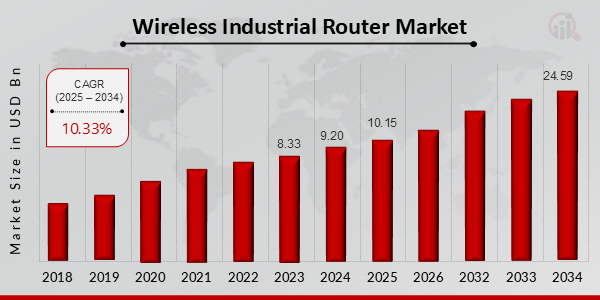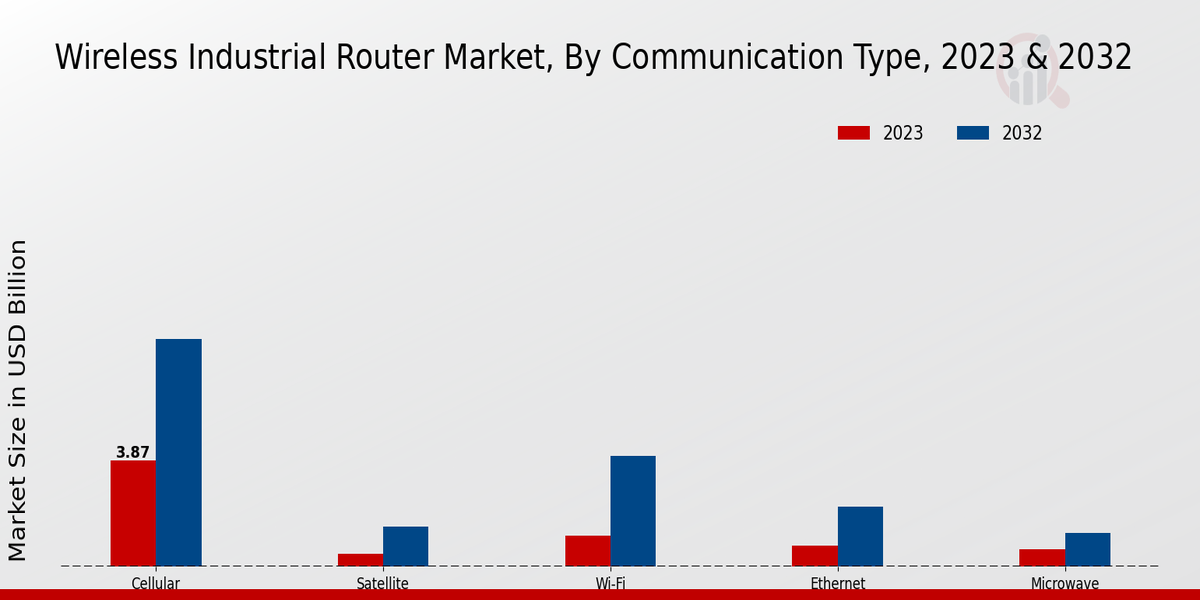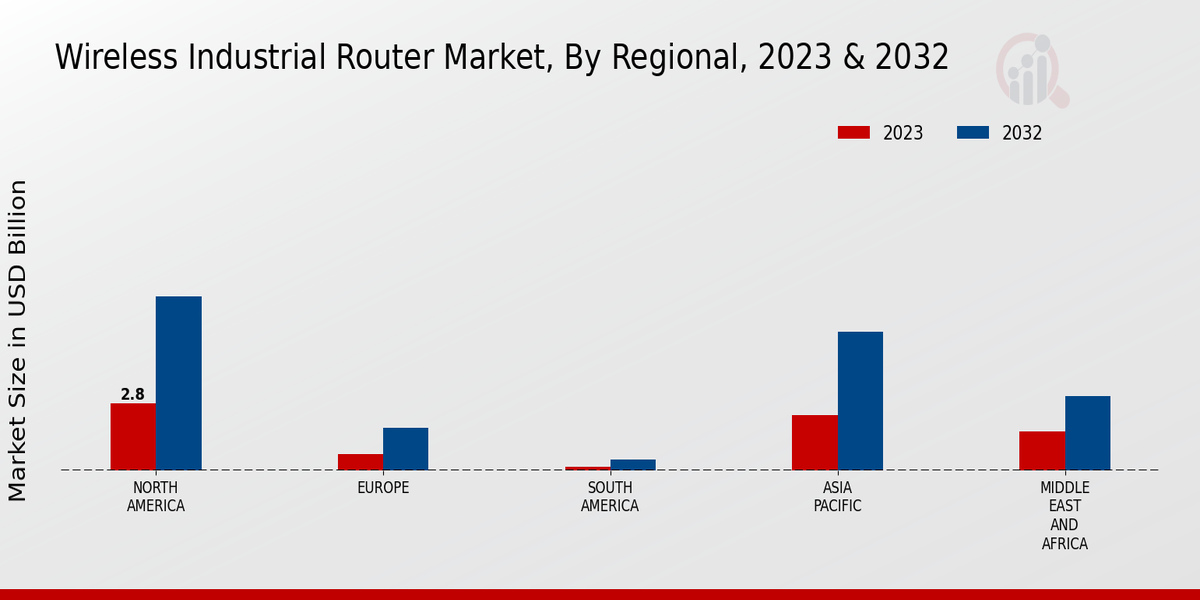Wireless Industrial Router Market Overview
Wireless Industrial Router Market is projected to grow from USD 10.15 Billion in 2025 to USD 24.59 Billion by 2034, exhibiting a compound annual growth rate (CAGR) of 10.33% during the forecast period (2025 - 2034).
Additionally, the market size for Wireless Industrial Router Market was valued at USD 9.20 billion in 2024.
Key Wireless Industrial Router Market Trends Highlighted
The growing adoption of automation and Industrial IoT (IIoT) has fueled the demand for wireless industrial routers. The surge in need for secure and reliable connectivity in industrial settings is driving market demand. Additionally, the proliferation of smart cities and intelligent transportation systems has created new opportunities for wireless industrial routers.
Key drivers of the wireless industrial router market include the need for improved efficiency, enhanced productivity, and remote monitoring capabilities. The adoption of Industry 4.0 and the increasing use of wireless devices in industrial environments are creating significant growth opportunities.
Recent trends in the wireless industrial router market include the emergence of 5G technology, which offers ultra-low latency and high bandwidth, enabling real-time data transmission and control. Additionally, the rise of cloud computing and edge computing has led to the emergence of cloud-managed and edge-deployed industrial routers that provide centralized management and increased flexibility.
Figure 1: Wireless Industrial Router Market size 2025-2034

Source: Primary Research, Secondary Research, Market Research Future Database and Analyst Review
Wireless Industrial Router Market Drivers
Rising Demand for Industrial Automation and IoT
The increasing adoption of industrial automation and the Internet of Things (IoT) is driving the growth of the Global Wireless Industrial Router Market Industry. As industries strive to improve efficiency, productivity, and safety, they are deploying more connected devices and sensors to monitor and control their operations. Wireless industrial routers provide reliable and secure connectivity for these devices, enabling them to transmit data to and from the cloud or other central systems.The growing demand for industrial automation and IoT solutions is expected to continue to fuel the growth of the wireless industrial router market in the coming years.
Government Initiatives and Support for Industrial Development
Governments worldwide are recognizing the importance of industrial development for economic growth and job creation. They are implementing various initiatives and providing support to industries, including incentives for the adoption of advanced technologies such as wireless industrial routers. These government initiatives are creating a favorable environment for the growth of the Global Wireless Industrial Router Market Industry.
Advancements in Wireless Technologies
Global Wireless Industrial Router Market By Technology Other key drivers of global wireless industrial router market industry is the rapid progress in wireless technologies. Today, new technologies for wireless networking, such as 5G and Wi-Fi 6 are introduced, which provide faster speeds and more stable connections. In addition, they allow for a greater number of devices and applications to be supported by wireless industrial routers.
Wireless Industrial Router Market Segment Insights
Wireless Industrial Router Market Communication Type Insights
The Global Wireless Industrial Router Market is segmented by communication type into Cellular, Satellite, Wi-Fi, Ethernet, Microwave, Zigbee, and LoRaWAN. Among them, Cellular is anticipated to hold the largest market share by 2023, because of its wide coverage, speed and reliability. The Cellular segment corresponds to 9.8% CAGR during the forecast period and is expected to get to a market value of USD 8.9 billion by 2032. Satellite communication is also an important segment exhibiting high growth rates. The lack of terrestrial networks and the demand for network connectivity in such isolated places considerably fuels the growth of the segment.
The Satellite segment corresponds to 10.5% CAGR throughout the forecast period and is expected to reach a market value of USD 3.2 billion by 2032. Wi-Fi is another important communication type representing the Wireless Industrial Router Market. The growing popularity of Wi-Fi enabled devices, such as smartphones, tablets and laptops significantly drive the growth of the Wi-Fi segment. The Wi-Fi segment corresponds to 9.3% CAGR throughout the forecast period and is expected to reach a market value of USD 2.6 billion by 2032.
Wired communication technology used for devices connecting in neighboring spaces is called Ethernet.It has an 8.7% CAGR and is expected to be equal to a market value of USD 1.8 billion by 2032. One more communication type is the Microwave segment, which is used for the long-distance data transmission based on radio waves. It corresponds to 9.1% CAGR and gets to a market value of USD 1.5 billion by 2032. Both Zigbee and LoRaWAN represent low-power wireless communication types. They are designed for connecting different devices used in industrial applications such as sensors, actuators and controllers.
Zigbee corresponds to 10.2% CAGR achieving a market value of USD 1.2 billion by 2032, while LoRaWAN corresponds to 11.4% CAGR and gets to a market value of USD 1.1 billion by 2032.

Source: Primary Research, Secondary Research, Market Research Future Database and Analyst Review
Wireless Industrial Router Market Security Features Insights
Security Features Security features are vital for wireless industrial routers, as they protect sensitive data and communications from unauthorized access. The Global Wireless Industrial Router Market is expected to witness significant growth in the coming years, driven by increasing demand for secure and reliable connectivity in industrial applications. Key security features include Firewall:Protects the network and connected devices from unauthorized access and malicious attacks. VPN: Establishes a secure encrypted connection between remote users and the network, ensuring data privacy and confidentiality.
Intrusion Detection and Prevention: Monitors network traffic for suspicious activities and takes action to prevent or mitigate threats. Anti-Malware: Detects and blocks malicious software, such as viruses, worms, and Trojans, to protect the network and connected devices. Access Control: Restricts access to the network and its resources based on user roles and permissions, preventing unauthorized access to sensitive data. Data Encryption: Encrypts data transmitted over the network, ensuring its confidentiality and protecting it from eavesdropping.
The market for security features in wireless industrial routers is expected to grow significantly in the coming years, driven by increasing demand for secure and reliable connectivity in industrial applications. Key players in the market include Cisco, Moxa, Siemens, and Advantech.
Wireless Industrial Router Market Industrial Applications Insights
The Industrial Applications segment is projected to generate substantial revenue in the Global Wireless Industrial Router Market, with a predicted valuation of USD 11.08 billion by 2024. This segment encompasses a wide range of industries, including Energy and Utilities, Manufacturing, Transportation and Logistics, Smart Cities, Mining and Construction, Healthcare, and Agriculture. Energy and Utilities are a key driver of growth, as wireless industrial routers enhance grid efficiency, remote asset monitoring, and smart metering. Manufacturing benefits from improved connectivity for automation, inventory management, and predictive maintenance.
Transportation and Logistics leverage wireless routers for fleet tracking, cargo monitoring, and supply chain optimization. Smart Cities utilize these routers for traffic management, public safety, and environmental monitoring. Mining and Construction employ them for remote site connectivity, equipment tracking, and safety applications. Healthcare benefits from wireless routers for patient monitoring, telemedicine, and asset tracking. Agriculture utilizes them for precision farming, livestock monitoring, and irrigation control. These industry-specific applications contribute significantly to the overall growth of the Wireless Industrial Router Market.
Wireless Industrial Router Market Form Factor Insights
Ruggedized Wireless Industrial Routers held the largest market share in 2023, driven by the increasing demand for industrial automation in harsh environments. Compact and Wall-Mounted form factors are expected to witness significant growth over the forecast period due to their suitability for space-constrained applications and ease of installation. Din-Rail Mounted and Rack-Mounted form factors cater to specific industrial requirements, such as control panels and data centers, respectively. The Global Wireless Industrial Router Market revenue is projected to reach USD 12.36 Billion by 2027, exhibiting a CAGR of 11.2% during the forecast period, 2024-2027.
The market growth is attributed to the rising adoption of Industry 4.0, the expansion of the manufacturing sector, and the growing need for reliable and secure industrial networking solutions.
Wireless Industrial Router Market Operating System Insights
The Operating System segment of the Global Wireless Industrial Router Market is expected to witness significant growth in the coming years. The growth of this segment can be attributed to the increasing adoption of Linux-based operating systems in industrial applications due to their open-source nature, customizability, and high reliability. In 2023, the Linux operating system accounted for the largest share of the Global Wireless Industrial Router Market revenue, and this trend is expected to continue in the coming years.
Other operating systems such as Windows Embedded, VxWorks, Xenomai, and Embedded Operating Systems (e.g., FreeRTOS, Zephyr) are also expected to experience growth in the coming years due to their specific features and applications in industrial environments.
The increasing demand for wireless industrial routers in various industries such as manufacturing, energy, and transportation is expected to drive the growth of the Operating System segment in the Global Wireless Industrial Router Market.
Wireless Industrial Router Market Regional Insights
The Global Wireless Industrial Router Market is expected to witness significant growth in the coming years, with the market size projected to reach USD 10.3 billion by 2027. Regionally, North America is anticipated to hold the largest market share, followed by Europe and APAC. The growth in these regions can be attributed to the increasing adoption of wireless technologies in industrial applications, such as manufacturing, transportation, and utilities. In North America, the market is expected to be driven by the growing demand for wireless connectivity in oil and gas, mining, and construction industries.
Europe is also witnessing a surge in the adoption of wireless industrial routers, particularly in the automotive and manufacturing sectors. The APAC region is expected to experience the highest growth rate due to the increasing industrialization and urbanization in countries such as China and India. The growing demand for wireless connectivity in smart cities and industrial IoT applications is further contributing to the growth of the Wireless Industrial Router Market in this region.

Source: Primary Research, Secondary Research, Market Research Future Database and Analyst Review
Wireless Industrial Router Market Key Players and Competitive Insights
Major players in the Wireless Industrial Router Market industry are constantly striving to gain a competitive edge by introducing innovative products, expanding their geographical reach, and forming strategic partnerships. Leading Wireless Industrial Router Market players are investing heavily in research and development to enhance the capabilities of their products and meet the evolving demands of various industries. The Wireless Industrial Router Market development is fueled by the increasing adoption of automation, remote monitoring, and data analytics in various sectors. The competitive landscape is expected to remain dynamic, with new entrants and established players vying for market share.
A leading company in the Wireless Industrial Router Market is Cisco Systems. Cisco offers a wide range of wireless industrial routers, such as the Cisco Industrial Routers IR800 Series, which are designed to meet the specific needs of industrial environments. The company's products are known for their reliability, security, and scalability. Cisco has a strong global presence and a well-established distribution network, which enables it to reach a wide range of customers. The company also provides a variety of support services, including technical support, training, and consulting.
A competitor in the Wireless Industrial Router Market is Moxa Technologies. Moxa offers a comprehensive portfolio of wireless industrial routers, including the Moxa UC-8100 Series, which are designed for harsh industrial environments. The company's products are known for their high performance and durability. Moxa has a strong focus on research and development, and it invests heavily in new product development. The company has a global presence and a well-established distribution network. Moxa also provides a range of support services, including technical support, training, and consulting.
Key Companies in the Wireless Industrial Router Market Include
Wireless Industrial Router Market Industry Developments
The global Wireless Industrial Router Market is projected to reach USD 18.3 billion by 2032, exhibiting a CAGR of 10.33% during the forecast period (2024-2032). This growth is attributed to the increasing adoption of wireless technologies in industrial settings, growing demand for remote monitoring and control, and the need for reliable and secure connectivity. Key market trends include the integration of advanced technologies such as 5G, AI, and IoT, the rise of Industry 4.0, and the growing adoption of cloud-based solutions.
Recent news developments include the launch of new products by major players such as Cisco, Moxa, and Sierra Wireless, and strategic partnerships and acquisitions to expand market reach and enhance product portfolios.
Wireless Industrial Router Market Segmentation Insights
-
Wireless Industrial Router Market Communication Type Outlook
-
Wireless Industrial Router Market Security Features Outlook
-
Wireless Industrial Router Market Industrial Applications Outlook
-
Wireless Industrial Router Market Form Factor Outlook
-
Wireless Industrial Router Market Operating System Outlook
-
Wireless Industrial Router Market Regional Outlook
|
Report Attribute/Metric
|
Details
|
|
Market Size 2024
|
9.20 (USD Billion)
|
|
Market Size 2025
|
10.15 (USD Billion)
|
|
Market Size 2034
|
24.59 (USD Billion)
|
|
Compound Annual Growth Rate (CAGR)
|
10.33% (2025 - 2034)
|
|
Report Coverage
|
Revenue Forecast, Competitive Landscape, Growth Factors, and Trends
|
|
Base Year
|
2024
|
|
Market Forecast Period
|
2025 - 2034
|
|
Historical Data
|
2019 - 2023
|
|
Market Forecast Units
|
USD Billion
|
| Key Companies Profiled |
Kepware, Rockwell Automation, ABB, Cisco, Schneider Electric, Advantech, Siemens, Westermo, eWON, Moxa, Sierra Wireless, Stratus Technologies, Hirschmann, Phoenix Contact |
| Segments Covered |
Communication Type, Security Features, Industrial Applications, Form Factor, Operating System, Regional |
| Key Market Opportunities |
Increased adoption in smart manufacturing Industrial IoT expansion growing need for remote monitoring and control rising demand for secure and reliable connectivity expanding wireless infrastructure |
| Key Market Dynamics |
Increased demand for automation proliferation of IoT devices government initiatives for smart cities growing adoption in manufacturing enhanced connectivity needs |
| Countries Covered |
North America, Europe, APAC, South America, MEA |
Frequently Asked Questions (FAQ):
The global Wireless Industrial Router market was valued at approximately USD 7.56 billion in 2023 and is expected to reach around USD 24.59 billion by 2034, expanding at a compound annual growth rate (CAGR) of nearly 10.33% during the forecast period.
North America is expected to hold the largest market share in the global Wireless Industrial Router market due to the presence of numerous manufacturing industries and increasing adoption of automation technologies. Asia Pacific is also projected to witness significant growth owing to rapid industrialization and rising demand for connectivity solutions in various sectors.
The major application segments contributing to the Wireless Industrial Router market growth include manufacturing, energy and utilities, transportation and logistics, healthcare, and retail. These industries rely heavily on wireless connectivity to enhance operational efficiency, improve communication, and support remote monitoring and control.
The key players operating in the Wireless Industrial Router market include Cisco, Moxa, Siemens, Belden, Westermo, Lantronix, Advantech, Phoenix Contact, and Rockwell Automation. These companies offer a wide range of wireless industrial routers with varying features and capabilities to meet diverse industry requirements.
The key trends shaping the Wireless Industrial Router market include the increasing adoption of Industry 4.0 technologies, growing demand for secure and reliable connectivity, advancements in wireless communication technologies such as 5G and Wi-Fi 6, and the rising need for remote monitoring and control in various industrial applications.
The Wireless Industrial Router market faces certain challenges, including intense competition, stringent regulatory requirements, the need for specialized expertise in wireless networking, and security concerns related to data transmission in industrial environments.
The COVID-19 pandemic had a moderate impact on the Wireless Industrial Router market. While some industries experienced a slowdown in demand, other sectors such as healthcare and remote infrastructure witnessed increased adoption of wireless industrial routers to support remote operations and maintain connectivity.
The future growth of the Wireless Industrial Router market looks promising due to the increasing demand for wireless connectivity solutions in various industries, advancements in technology, and the growing adoption of automation and digitalization across industries.
The Wireless Industrial Router market is subject to various regulatory requirements related to wireless communication standards, data security, and electromagnetic compatibility. Adherence to these regulations is crucial for market participants to ensure compliance and avoid penalties.
Businesses can leverage the opportunities in the Wireless Industrial Router market by investing in advanced technologies, developing innovative products and solutions, strengthening partnerships, and focusing on providing excellent customer service. By aligning their offerings with industry trends and addressing specific customer needs, they can gain a competitive advantage and drive growth.

















